HOME PAGE


|
Bhagavad-Gita:
18 Chapters in
Sanskrit
BGALLCOLOR.pdf |
|
Download Bhagavadgita-all 18 chapters in Sanskrit,
English, |
|
transliteration and word for word translation. |
Bhagavadgita Pages in English,
Chapters 1 to 18


Veeraswamy Krishnaraj
|
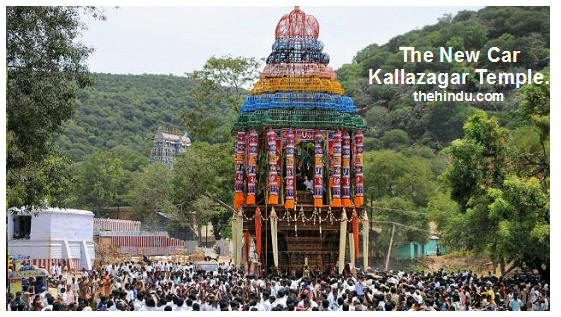
The new temple car in
Alagarkoil on a trial run.— Photo: R. Ashok
MADURAI, July
7, 2015 thehindu.com
Lord Sundararaja Perumal Temple at Alagarkoil now has
a new temple car.
According to local priests, it has replaced a car that was used for
nearly 300 years. Work on the new car began nearly two years ago
with donations from devotees and philanthropists. The trial run of
the car was conducted on Monday.
“The Anandhanarayanan
thiru ther was used
by the temple for the last 300 years for the annual procession
during Adi festival,” said Sundaranarayana Bhattar, the head priest
of the temple.
On the features of the new temple car, K. Selvam, the stapathi who
built it with a team of 15 artisans, said that they had used Vengai tree
wood for the structure and Burma teakwood for sculptures.
“We have tried to replicate the intricate craftsmanship on the old
temple car, while maintaining the traditional design in the new car.
There are more than 500 sculptures of sages, celestial beings and
deities on it,” he said.
Finishing touches to the new car, built at an estimated cost of Rs.
81 lakh, were given on Saturday morning and it was decked up before
it was taken on a trial run on the route taken during Adi utsavam .
The
car built using Vengai tree wood will be taken out in a procession
during
Adi festival
|
May 3, 2015.
thehindu.com
Lord Kallazhagar, the presiding deity of the
Kallazhagar temple at Alagarkovil began his journey to Madurai as part
of the temple’s Chithirai festival here on Saturday evening (2nd May).
The deity was brought out from a mandapam inside the temple on a
palanquin at 6.15 p.m. amidst chanting of hymns by thousands of
devotees who thronged the temple to get a glimpse of the Lord before
He started His journey to Madurai.
Edhirsevai’
The procession is expected to reach Moondrumaavadi at 6 a.m. for the
‘Edhirsevai’ on Sunday (3rd May, 2015). Temple authorities said that
there were 410 ‘mandagapadis’ where the procession was expected to
stop.
As one of the highlights of the festival, Lord Kallazhagar will enter
the Vaigai river at 6.45 a.m. on Monday. A temple official said that
following talks with the city police, they had set up LED screens at
five vantage points where the crowds were said to be the maximum to
enable the public to see the proceedings.
The LED screens will be set up at three places near the Vaigai
riverbed, at the Tallakulam Perumal Temple and at Goripalayam
junction.May 04, 2015 Monday.
report on May 5, 2015 05:59 IST thehindu.com
Lord Kallazhagar making His
entry into the river as a part of the Chithirai festival, here on
Monday.
A festive spirit prevailed in the temple city all through Sunday night
as devotees dressed in colourful attire took part in celebratory
dances and chanted hymns. Since the river was in full flow with the
release of water ahead of the festival, the public began assembling on
the banks of the river from as early as 4 a.m. to witness the
spectacle.
Lord Kallazhagar, the presiding deity of the Kallazhagar temple at
Alagarkovil, arrived near the river bed at 6.25 a.m. amidst loud
chants of ‘Govinda Govinda’ by devotees. He was received by Lord
Veeraraghava Perumal who was mounted on a silver horse, as is the
custom.
While the celestial wedding of Goddess Meenakshi and Lord
Sundareswarar, and Lord Kallazhagar’s entry in the Vaigai were a part
of two separate Chithirai festivals, it was during the reign of King
Thirumalai Naicker that the two were linked.
Lord Kallazhagar entered the Vaigai at 6.45 a.m. and was taken in a
procession around the mandapam erected in the riverbed near the Albert
Victor Bridge.
The popular belief is that Lord Kallazhagar, who sets out from
Alagarkovil to attend the marriage of His sister Goddess Meenakshi, is
stopped by Lord Veeraraghava Perumal, who tells him that the marriage
has already been solemnised. Dejected on hearing this, Lord
Kallazhagar chooses not to cross the river but goes into it.
MADURAI
Alagharkoil
thehindu.com
MADURAI, May 7, 2015
Updated: May 7, 2015 05:58 IST
Ten avatars re-enacted
The sixth day of the brahmotsavam of Sundararaja Perumal Temple
at Alagarkoil featured Lord Kallazhagar appearing in the ten avatars,
Dasavataram, of Lord Vishnu at Ramarayar Mandapam on the northern bank
of the Vaigai in Madurai on Tuesday night. This was followed by an
early morning procession on Wednesday.
According to a legend,
Mandooga
Maharishi,
after his redemption from
Doorvasar’s
curse by Lord
Kallazhagar near the
Thenur
Mandapam
the previous day, expressed a desire to see all the 10 avatars of Lord
Vishnu. Granting his wish, Lord
Kallazhagar
appeared in Dasavataram
on the banks of the
Vaigai. This event is
re-enacted on the sixth day of the
Chithirai
festival.
People, who flocked to Madurai in large numbers during the
Chithirai festival, assembled around the Ramarayar Mandapam to see
Lord Kallazhagar in Dasavataram – Matcha, Koorma, Varaha, Narasimha,
Vamana, Parasurama, Rama, Balarama, Krishna and Kalki avatars. The
belief is that Lord Vishnu descends on earth whenever dharma is
threatened by evil forces.
|
| December 25, 2012 Tuesday. Thousands of devotees thronged the
Vaishnavaite temples in Madurai, in the early hours of Monday (Dec 24,
2012) on the occasion of ‘Vaikunta Ekadasi’. |
| Vaikunta Ekadasi falls on the 11th day of the Sukla Paksha (waxing
phase of moon) of Dhanur (Margazhi) month. |
| The ritual of opening of ‘Paramapada
Vaasal’ was performed at Prasanna Venkatachalapathy Temple in
Madurai and Kallalagar Temple in Alagarkovil at 5 am. Devotees braved
the chill weather to catch a glimpse of Lord Vishnu coming out of the
temple as part of the ritual of entering the ‘Paramapada Vaasal’.
thehindu.com பரமபத வாசல் = Paramapada Vaasal
= Gateway to SriVaishnava heaven. |
Kallazhakar_Temple
Kallaz5.jpg
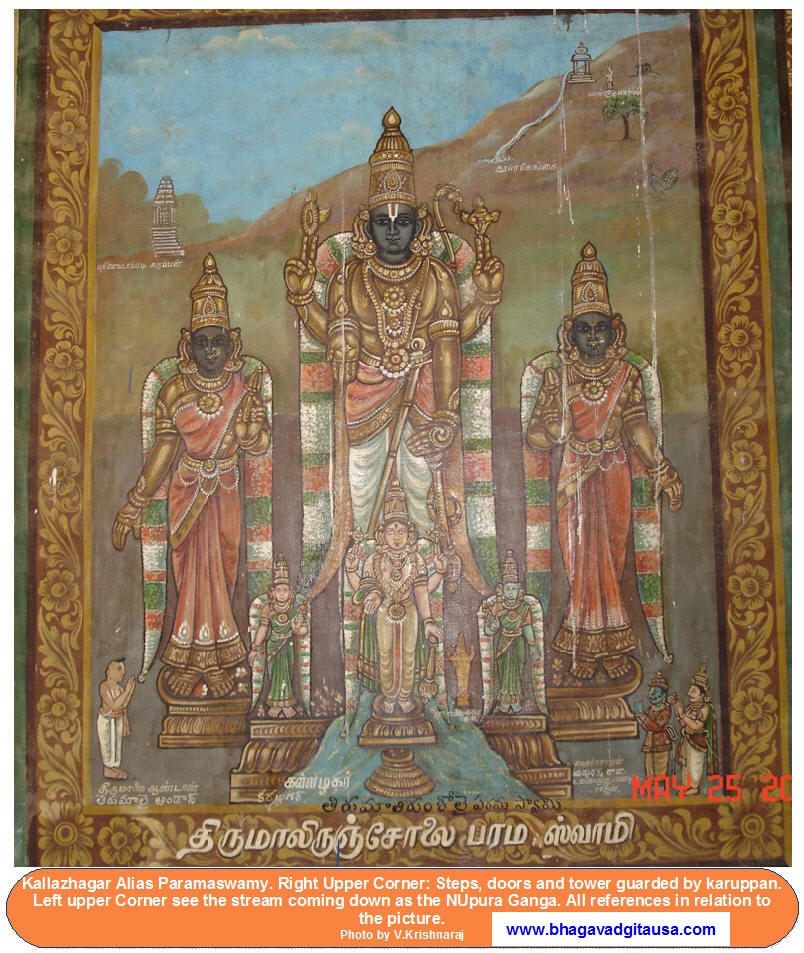
Azhagar hills (அழகர் மலைகள்) grace the landscape twelve miles north-east
of the city of Madurai, whose resident Goddess is Madurai Meenakshi.
Soundararaja Perumal, the brother of Meenakshi, is the resident God of the
land adjoining the temple on its south. Here you can see the family
constellation of Saivite Meenakshi and Vaisnavite Perumal. Azhagar, meaning
The Beautiful, is the tutelary deity of Kallars (கள்ளர் = the name of a
caste) Azhagar goes by many names: Sundarajar, Paramaswamy,
Rishabhadrinathar, Kallazhagar. This temple exists from the early part of
Christian era, according to one account. The stone Mantapam is the Pavilion
in a temple or other place used during festivals for the reception of idols
when they are carried in procession, generally a square or rectangular hall
with a flat roof. The Lord is in a standing position as in the photo holding
the conch, the discus, the club, the bow and the sword, known as the five
weapons (= பஞ்சாயுதம் = Panchayutha).
The temple is mentioned in Puranas. The story goes like this. Yama the
Lord of Death was on a pilgrimage, landed in this place, fell in love with
it and sat down to perform Tapas. Sriman Narayana appeared before him and
offered salvation. Not pleased with salvation just for himself, he begged
Narayana to stay in there and offer blessings and salvation to all the
people. Yama saw a halo of the moon surrounded the place. Yama asked
Visvakarma, the architect for the gods to build a Vimanam (விமானம் = temple)
in that very spot graced by the halo of the moon. Narayana and His Consorts
BhUdevi and Sridevi took residence in the temple. This Vimanam is known as
Soma-Sundara-Vimanam (Moon-beauty-temple), Soma-Skanda-Vimanam (Moon-Skanda-Temple
= God Skanda also resides here with His Consorts) and Somachanda Vimanam.
Silambar river flows near the temple and brings fruition of desires of
the bathers. When Vamana (the Dwarf Avatara of Vishnu) expanded and lifted
his left foot which reached the firmament, wherein Brahma washed the foot
with water from his Kamandalam (= கமண்டலம் = Water-vessel used by ascetics).
Ablution of the foot displaced the diamond anklet (NUpura)
a bit and the water trickled down from the anklet and flowed as the river
Silambar. silampu = சிலம்பு = Tinkling anklets; silampar = சிலம்பன் =
Skanda, as Lord of the hilly tract; silampu = சிலம்பு = Mountain slope.
The River Nupura Ganga flows from the spring at the feet of RakkayI
Amman Temple.
This temple was sung in Paripadal and dates back to 2000 years.
Sthalapuranam (= history of the place = ஸ்தலபுராணம்) indicates that king
Malayadvaja built this temple. Alvars (ஆழ்வார்) sang on the glory of this
temple; 123 of the poems can be found in Nalayira Divya Prabhandam, the
Tamil Veda of SriVaishnavites. Pandya and Naick Kings were the main sponsors
in the upkeep of the temple. This temple is one of the 108 holy places for
SriVaishnavites. Hyder Ali looted the temple blind in the 18th century.
The hills are the abode of temples for Ganesa, Skanda, Bhairava and Siva.
The Azhagar temple as usual has a MUlavar (மூலவர் = mūlavar = Idol
fixed in the sanctum sanctorum) and Urcavar (உற்சவர்
uṟcavar = Idol taken out in processions; Processional
deity). Azhagar is the processional deity; Paramaswamy is the
Mulavar or the fixed deity. Azhagar, the beautiful, the Processional Deity
Idol) (உற்சவர்) is flanked by His consorts. Paramaswamy, the Presiding and
fixed Deity (மூலவர்) in the shrine sports the discus in a prayoga state (பிரயோகம்
= imminent stage of deployment).
The temple has shrines for Vinayaka and Sarasvati. Ordinarily, Vinayaka
sports his proboscis pointing towards the left. In the other form as in this
temple, his proboscis is bent towards the right; this pose earns him the
name Valampuri Vinayakar (வலம்புரி விநாயகர்). Vinayaka with dextro-positional
proboscis is installed in well-to-do temples. Kallaz2.jpg
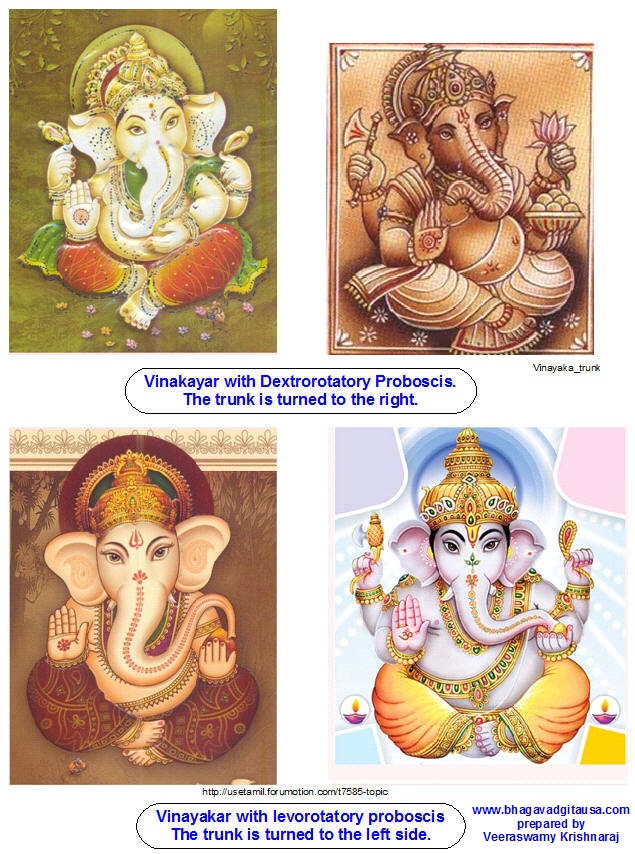
Lord Bhirava rides on a dog with a trident, long nails, and fierce teeth
in one shrine. There are shrines for Andal and Sundaresvarar, the latter
with 16 hands carrying weapons on each, three eyes and long teeth showing
his Gora Svarupam (Fierce appearance), going by the name
Jvala Narasimhar (blazing man-Lion). The
ceiling in the shrine has a hole which helps dissipate the heat of His
disposition. The priests cool him down by abhisekam (ablution) with milk and
dairy products. The place has plethora of shrines for Alvars, Ramanuja,
minor deities, Ashtabhuja Krishna, Nartana Krishna, Manduka Maharishi,
Parthasarathi, Sarasvati.... Kallaz3.jpg
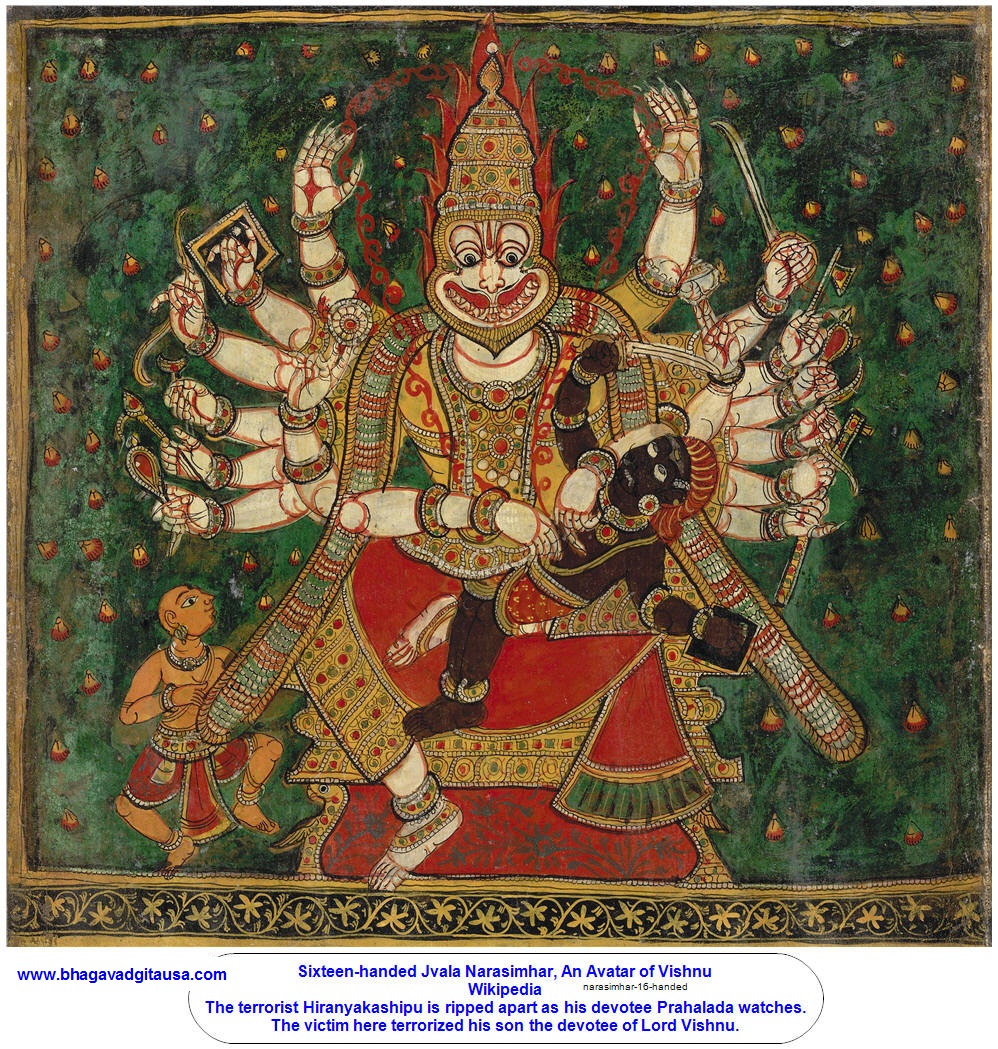
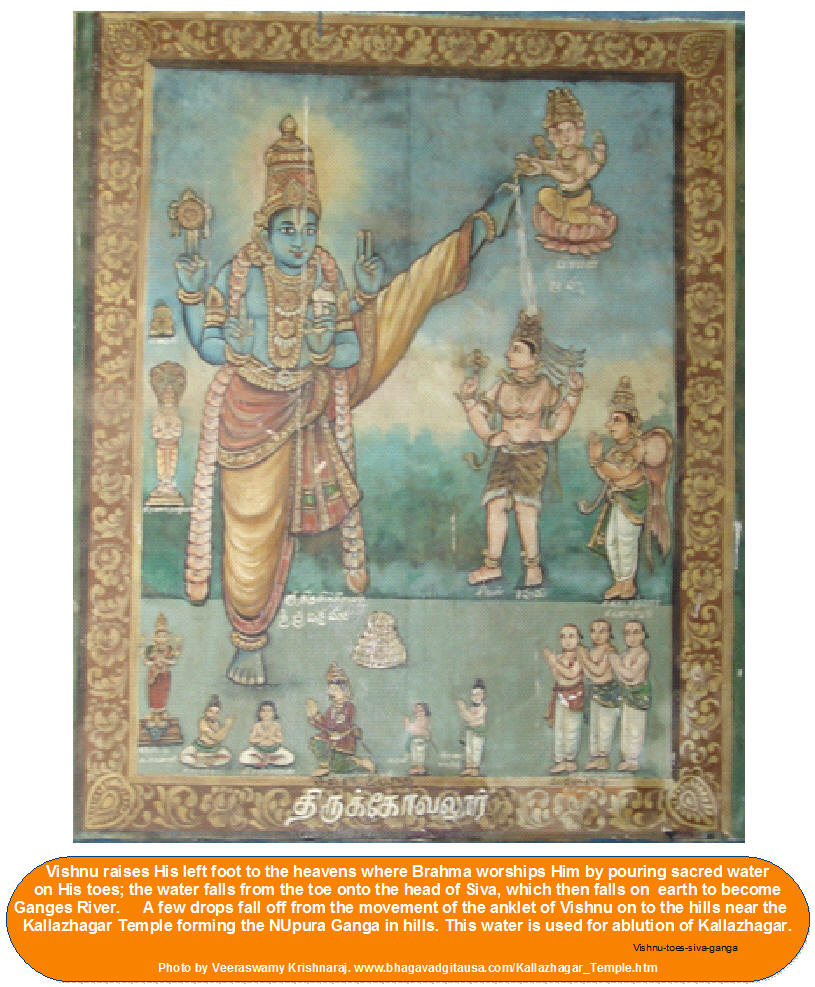
The guardian deity of the temple day and night, a form of Krishna Putra,
is Karuppannaswami (Black Deity). He is the one without a shrine; the two
massive doors are dedicated to him perching at the top of 18 steps. I assume
he has to guard without being seen by others. These doors stay closed always
except once in a year, when Brahmotsavam is celebrated. Anyone ascending the
18 steps and going through the open doors should be a truth sayer with a
stipulation that the errant soul may face misery. Consider "Janus the
ancient Roman god of doorways, of beginnings, and of the rising and setting
of the sun, usually represented as having one head with two bearded faces
back to back, looking in opposite directions, east and west."--Dictionary.
The water brought everyday for ritual ablution of the deities should be
declared clean from NUpura Ganga at the doors. The doors being the surrogate
for the invisible Karuppanna Swami stand there as the witness in front of
whom the list of jewels of Azhagar are declared before the jeweled Azhagar
departs to attend His sister's (Meenakshi) marriage in Madurai. This
enumeration is a daily event in the temple. The guardian of the 18 steps and
the door is called Patinettuppadi Karuppan (the 18 step Karuppan). Around
the temple locale, there are many shrines for snake worship indicating that
this area was once inhabited by Naga tribals (Snake-worshipping tribals).
There are many Tirthams with holy water from which water is brought for
ritual ablution of the deities.
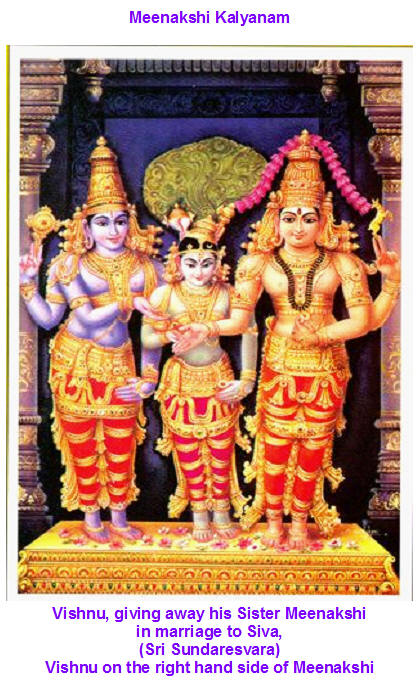
The important festival is Chitra Pournami (Full moon in the month of
Chitrai), when Azhagar goes to Madurai to attend Meenakshi's marriage to
Siva (Sundaresvarar). This is an instance of bringing the Saivites and
SriVaishnavites together.
Festivals: The
Chittirai festival is a grand one, where on the fourth day, Azhagar is
taken to Madurai, where he resides on the banks of the Vaigai river for
five days and then returns. Chittirai is the month of great festivities in
Madurai, for it is when, the grand Chittirai Tiruvizha of
Madurai
happens, attracting thousands of visitors. The festival images (gold) here
are of great beauty. Bhramotsavam is celebrated in the month of Aadi,
Vasantotsavam in Vaikasi. Tirukkalyanam is celebrated in the month of
Pankuni, when Sri Devi, Bhu Devi, Kalyanasundaravalli and Andal are seen
with Vishnu. On Dwadasi in the bright half of Aippasi, the festival image
of Azhagar is given a ritual bath in Noopura Ganga.
http://www.templenet.com/Tamilnadu/df102.html http://hubpages.com/hub/Alagar-malai-Alagar-kovil
பழமுதிர்சோலை paḻam-utir-cōlai is a temple on the hill for Kanthan also
known as Skanda.
A shrine sacred to Skanda, one of six paṭai-vīṭu, q.v.;
முருகக்கடவுளின் படைவீடு ஆறனுள் ஒன்று. (திருமுரு.
Here are the verses in Divyaprabhandam with reference to Kallazhakar,
the presiding God of the Temple and His sacred exploits.
The following Divyaprabhandam
verses are relevant to this Sthalam.
|
226:
மைஆர்
கண் மட ஆய்ச்சியர் மக்களை மையன்மை செய்து அவர் பின் போய்
கொய்ஆர்
பூந்துகில் பற்றித் தனிநின்று குற்றம் பல பல செய்தாய்;
பொய்யா!
உன்னைப் புறம் பல பேசுவ புத்தகத்துக்கு உள கேட்டேன்
ஐயா!
உன்னை அறிந்து கொண்டேன் உனக்கு அஞ்சுவன் அம்மம் தரவே. 3.4 (DP226)
226. You induced love in cowherd girls with
collyrium-laden eyes, went behind them hanging on to their beautiful
pleated Saris and perpetrated many (many) harms in secluded places.
O Liar! I heard many slanders about you and could write a book
containing all the slanders about You. O Father (ஐயா)!
I have come to know You well. I would be afraid to let You
suckle my breasts (அம்மம்). (Krishna as a
suckling infant killed an ogre who offered her breasts laced with a
poison; Bhagavan sucked her breasts and killed her.) Translation:
Veeraswamy Krishnaraj Copyright
In Ayarppa, there is a mention of the place,
Malirumsolai, the king and the bridegroom of Malirumsolai. |
|
338 அலம்பா
வெருட்டாக் கொன்று திரியும் அரக்கரைக்
குலம் பாழ் படுத்துக்
குலவிளக்காய் நின்ற கோன் மலை
சிலம்பு ஆர்க்க வந்து
தெய்வ மகளிர்கள் ஆடும் சீர்ச்
சிலம்பாறு பாயும்
தென் திருமாலிருஞ் சோலையே 1
The Arakkars (Anti-gods) were
roaming and subjecting the living beings to trouble, travail and
massacre. The Lord destroyed them by root (and trunk) and stood as the
Shining light of family in the TiruMalirumSolai Hill, wherein the
celestial damsels with jingling anklets indulged in water play in the
Nupura Ganga. Translation:
Veeraswamy Krishnaraj Copyright |
|
339
வல்லாளன் தோளும் வாள் அரக்கன் முடியும் தங்கை
பொல்லாத மூக்கும் போக்குவித்தான் பொருந்தும் மலை;
எல்லா இடத்திலும் எங்கும் பரந்து பல்லாண்டு ஒலி
செல்லா நிற்கும் சீர்த் தென் திருமாலிருஞ் சோலையே
2
The Lord, who cut asunder
and cast the heads and the shoulders of the mighty Arakkan (Demon
Ravana) and the nose of his evil sister (Sūrpanaka),
abides in famous MalirumSolai hill, wherein there is no place the
sound of Pallandu does not abound and pervade. Pallandu = Felicitation
of the Lord to live gazillion years. Translation:
Translation: Veeraswamy Krishnaraj Copyright |
|
340
தக்கார் மிக்கார்களைச் சஞ்சலம் செய்யும் சலவரைத்
தெக்கு ஆம் நெறியே போக்குவிக்கும் செல்வன் பொன்மலை;
எக் காலமும் சென்று சேவித்திருக்கும் அடியரை
அக் கான் நெறியை மாற்றும் தண் மாலிருஞ் சோலையே 3
The sea farers (சலவர் = euphemism for the demons among us), having
subjected the worthy and virtuous persons and the great ones to
trouble, are put on the Southern Path by the Selvan (the Lord of Great
wealth) abiding in the Golden Hill. The servitors, going always to His
place for worship, receive preventive guidance through the forest of
Karma; that is the greatness of the cool TirumālirumSolai.
Note: The Southern Path is for the impure souls to take after their
death to go to hell.
Translation: Translation: Veeraswamy
Krishnaraj Copyright |
|
341
ஆனாயர் கூடி அமைத்த விழவை அமரர்தம்
கோனார்க்கு ஒழியக்
கோவர்த்தனத்துச் செய்தான் மலை
வான் நாட்டில் நின்று மாமலர்க் கற்பகத் தொத்து இழி
தேன் ஆறு பாயும் தென் திருமாலிருஞ் சோலையே 4
The Lord, having stopped the festival in
honor of Indra by the gathering cowherds, made it the festival of the
Govardhana Hill. TiruMalirumSolai is the Hill wherein the nectar from
the great celestial Kalpaka flowers flow (as the Nupurta Ganga).
Translation:
Translation: Veeraswamy Krishnaraj Copyright |
|
342 ஒரு
வாரணம் பணி கொண்டவன் பொய்கையில் கஞ்சன்தன்
ஒரு வாரணம்
உயிர் உண்டவன் சென்று உறையும் மலை
கரு வாரணம்
தன் பிடி துறந்து ஓடக் கடல்வண்ணன்
திருவாணை
கூறத் திரியும் தண் மாலிருஞ் சோலையே 5
வாரணம் = elephant.
திருவாணை= Royal Order.
பிடி = female
elephant
The Lord delivered, out of the mouth of
the crocodile, the elephant that went into the lotus pond to fetch
flowers for worship (of the Lord). The Lord, taking the life of
another elephant (Kuvalayapida), set on by Kamsa to kill the Lord,
abides in the hill. That hill is TirumālirumSolai wherein the female
elephant escaping the pursuit of the black male elephant returns on
the Royal order of the Lord of color of the ocean.
Translation:
Translation: Veeraswamy Krishnaraj Copyright |
|
343 ஏவிற்றுச் செய்வான்
ஏன்று எதிர்ந்து வந்த மல்லரைச்
சாவத் தகர்த்த சாந்து
அணி தோள் சதுரன் மலை
ஆவத்தனம் என்று
அமரர்களும் நன் முனிவரும்
சேவித்திருக்கும் தென்
திருமாலிருஞ் சோலையே 6
ஆவத்தனம்
āvattaṉam = Property kept in reserve against future dire needs.
சேவி-த்தல்
= To serve, as under a master; to render service.
The Lord of the Hill killed the
wrestlers dispatched against Him by Kamsa and smeared the sandal paste
on His shoulders. The gods and Munis regard the Lord of the
TirmalirumSolai as their treasure reserve and serve Him.
Translation: Veeraswamy Krishnaraj Copyright |
|
344 மன்னர் மறுக
மைத்துனன்மார்க்கு ஒரு தேரின்மேல்*
முன் அங்கு
நின்று மோழை எழுவித்தவன் மலை;*
கொல்
நவில் கூர்வேற் கோன் நெடுமாறன் தென்கூடற்கோன்*
தென்னன் கொண்டாடும் தென்
திருமாலிருஞ் சோலையே* 7
மோழை
எழுவித்தவன் = the One who raised water
by shooting an arrow on the ground.
கோன் = king.
தென்கூடற்கோன் = the king of
the South Kūdal.
Causing distress to the kings (the
Kurus), the Lord who drove the chariot for his brother-in-laws (the
Pandavas) shot an arrow on the battleground to raise water (for the
horses). The Lord lives in TiruMalirumSolai hill, where king Nedumāran
of the South Kudal wielded killer-hard sharp spear and
celebrated his victory. Translation:
Veeraswamy Krishnaraj Copyright |
345 குறுகாத மன்னரைக் கூடு
கலக்கி வெங்கானிடைச்
சிறுகால் நெறியே போக்குவிக்கும்
செல்வன் பொன்மலை;
அறுகால் வரி வண்டுகள் ஆயிரநாமம்
சொல்லிச்
சிறுகாலைப் பாடும் தென்
திருமாலிருஞ் சோலையே 8
|

|
|
The auspicious Lord of the Golden Hill routs the
kings not seeking Him and sends them down narrow path of dense
forests. That is TiruMalirumSolai wherein the six-legged banded Bumble
bees wake up early in the morning and sing the thousand names of the
Lord. Translation: Veeraswamy Krishnaraj
Copyright. |
|
347 எட்டுத் திசையும் எண்
இறந்த பெருந் தேவிமார்
விட்டு விளங்க
வீற்றிருந்த விமலன் மலை;
பட்டிப் பிடிகள் பகடு
உரிஞ்சிச் சென்று மாலைவாய்த்
தெட்டித் திளைக்கும்
தென் திருமாலிருஞ் சோலையே 10
உரிஞ்சு-தல்
= To rub
oneself; to rub, as beasts; to rub against one another or trees.
தெட்டித் திளைக்கும் = to copulate
with force.
Among the umpteen celestial damsels
from all eight quarters, the Pure Lord sits on the hill. MālirumSolai
is the hill, wherein the elephant cows rub against each other,
copulate vigorously with the bulls all night long, and thus disport
themselves. Translation: Veeraswamy Krishnaraj
Copyright. |
July 11, 2011
Hindu reports:
The Mahasamprokshanam of the 1,500 year old
Kallazhagar temple, 20 km from here was performed on Sunday after a gap of
16 years, with thousands of devotees from all over Tamil Nadu offering
worship to the deity.
The temple had been renovated at a cost of
Rs.15 crore. More than 150 priests participated in the three-day yaga sala
pooja, which concluded on Sunday, following which Holy water in silver pots
were carried in a procession.
The Fit person of the temple Venkachalam,
State HR & CE Minister S P Shanmughanathan, Electricity Minister Natham R.
Viswanathan and cooperative minister Sellur K.Raju were among those present
on the occasion.
The Mahasamproksham was last performed in
1995.
The temple had been renovated at a cost of
Rs. 15 crore. The highlight of the renovation was gold plating of the
Vimanam atop the sanctum sanctorum, using 23kg of gold.
Tight security was in place for the event.
April 24, 2013 17:48 IST thehindu.com
When the Gods descend...
Amidst the sea of humanity, fluorescent flash lights, scent of incense
sticks and sandal paste, colourful flowers and the chorus chant of ‘Hara
Hara Shankara Meenakshi Sundara’ is
all that we can see, smell and hear. It’s the evening after the
Thirukalyanam and we are in South Masi Street.
There is absolute chaos and yet some order too. We hear the distinct jingle
of a bell that announces the arrival of the caparisoned temple elephant
leading the procession. Three camels, karagattam dancers, priests, children
dressed as deities and a posse of policemen follow.
Bhakti flows in abundance. Milling devotees who throng the place crane their
necks to catch a glimpse of the decorated idol kept in the poopallakku.
The aartiis
lit and in a synchronised movement, thousands of people raise their hands
calling out to the queen of Madurai. The golden idol gleams as women offer neideepam.
Every few yards the palanquin stops for the devotees to have darshan, give
offerings and get prasadams. We relish the ghee-dripping sakkarai
pongal and puliyodharai.
It’s a service that Shanmugam has been doing for decades. “Offering
prasadams to the people fetches me good karma,” he smiles. “Giving turmeric, kumkum and
flowers on the Thirukalyanam day is a traditional practice.”
By 9 p.m. the procession winds up but the crowd of spectators cluster around
the streets. We drive across the kalpaalam bridge and find hundreds of
people leaning over the parapet to watch the running water below. As the
southern bank of Vaigai revels in the joy of Meenakshi’s wedding, the
northern side wakes up to Lord Kallazhagar’s entry into the city.
The night before ethirsevai,
the arterial Alagar Koil Road wears a festive look flanked by mandapapadiswhich
were commercial outlets and eateries until a day ago and now transformed
into Lord Kallazhagar’s resting places. As dawn breaks, the Lord reaches the
city fringes with his elaborate paraphernalia. A huge hundi, a green flag
with the Thirunamam symbol
and dancing men dressed as Hanuman and Garuda signal his advent.
The metallic tinkling of ‘Sekandi’ announces
the Lord’s arrival. An old man dressed as a clown and playing the thathan
thappu, a kind of drum, leads the procession pulling a decorated bull.
The family of Karuppaiya Thathan has been doing this for generations. “We do
it as a service to God, from the King’s time,” his pride shows. A week
before the festival, the thathans visit villages and collect paddy to be
cooked and served to devotees.
Says R. Arul Prakasam, a farmer, “Those of us who donate paddy are offered a
fistful from the bundles of paddy collected. We use it in our next
cultivation because it’s a belief that this practice will increase the
yield.” Karuppaiya Thathan is also a temple priest in Sundararajanpatti and
a soothsayer for the village. “The right to foretell was given to us by Aandar of
Alagar Koil, who is also our guru,” he says.
Aandar is
in-charge of all the festivals of the temple. T.R.S. Rangarajan Iyengar, who
is the presentAandar, says, “We used to lead
the festival procession earlier. We had a separate palanquin which was
carried by the people. But now the practice is no longer followed.”
“Irrespective of caste and clan, every devotee is given a part to play in
the festival,” he adds.
As Kallazhagar reaches Surya Nagar amidst deafening crackers, flower showers
and traditional music of Nadaswaram and thavil, the crowd gathers to have
the first glimpse of the Lord. Womenfolk welcome the deity with Mulapari (sprouts)
and Maavilakku (sweet)
offerings. Men dressed in multicoloured pants with anklets, carrying whips
and leather water bags follow the Lord while Maralaadis,
a group of men dance with torches in front. By the time, the procession
reaches Ambalakarar
Mandapam at Tallakulam, the
crowd swells on the road and spills onto the platforms. The chants of ‘Govinda
Govinda’rent the air as the city’s denizens rub shoulders with visitors
from neighbouring districts.
“The folk legend of Alagar’s entry into the Vaigai is famous throughout the
region. Along the river’s course, the episode is enacted in various places,”
says Mariappan, a devotee from Sivagangai.
It is time for the ‘Seer
patham thangigal’ (palanquin
carriers) to take a break. Says Siva Guru Nathan, one among the 50 carriers:
“We don’t do this for remuneration. It’s a service and we feel blessed to
carry the lord on our shoulders.” Carrying the massive weight for years
together has left them with a hump on both the shoulders. “More than the
pain, the travails we go through when people pull down the palanquin trying
to touch the lord’s feet are beyond explanation,” he says.
While Chithirai festival is about faith and devotion, for some it’s an
experience and excitement. Beyond the myths and legends woven around the
occasion, the days are the best for small-time traders.
Shacks encroach the roadsides selling all kinds of colourful wares, toys and
balloons attracting women and kids alike. We watch them enjoying a range of
mithais, women buying bangles, anklets and earrings, children crying for
toys and smiles returning on their faces when the demand is met. Kitschy
posters showing a bodybuilder flexing muscles, dot the pavements at
Tallakulam. “Nellai
thaathupushti halwa” says the
poster in bright colours. Mohammed Farooq, a halwa-seller, says, “We have
been in this business for generations. We actually do not know why our
grandfathers gave this name. It is prepared with wheat and maida extracts,
sugar and cashew and we ensure it remains a healthy food.”
Tamukkam, the hotspot on the Lord’s route, lures thousands through the day
and night. For some it is a continuous picnic on the streets, some pitch
their tents at the annual Chithirai exhibition. The ground turns into an
open air bed for the devotees who come from far and near and finally get
tired wandering on the streets. Youngsters flock cinema theatres running
special mid-night shows. Says college student Ramesh, “It’s purely fun being
among the festivities and crowd. Every year, we never miss to watch a film
during the festival. As we come out of the show, it is time to witness
Alagar entering Vaigai.”
The Chithirai events and all the hype around it come and go each year. What
continues to rule the peoples’ mind is the legend and what remains in their
memory are the sights and smells of the festivities and the desire to return
the next year with undiminished enthusiasm.
The Chithirai thiruvizha is one mega event which gives Madurai its identity
and pride and all those who can join in it in some way consider themselves
to be blessed and lucky. Aren’t we?








